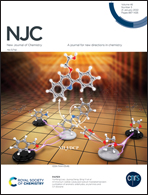Application of porous styrene resin loaded carboxymethyl cellulose-stabilized nano-zero-valent iron for highly efficient hexavalent chromium removal
Abstract
In order to improve the reactivity of nZVI for Cr(VI) removal, porous styrene resin loaded carboxymethyl cellulose-stabilized nano-zero-valent iron (CMC-D201@nZVI) was first prepared by the simple liquid phase reduction method. Its morphology, chemical properties and Cr(VI) removal performance were investigated. CMC–nZVI with nZVI as the core and CMC as the shell loaded on the surface of D201 exhibits excellent stability, longevity and regeneration performance. This is because the special framework structure of D201 weakens the agglomeration of nZVI, and the positively charged quaternary amine groups on its surface can electrostatically adsorb Cr(VI). nZVI enhances its stability through the combination of bidentate bridging with CMC. The CMC layer further improves the distribution and mobility of nZVI by electrostatic repulsion and steric hindrance, and simultaneously can complex the products (Fe(III), Cr(III), CrxFe1−xOOH or CrxFe1−x(OH)3) in the reaction system to promote the adsorption process. Under the conditions of pH 4.90, adsorption dose 50 mg, temperature 298 K, and shaker speed 150 rpm, the maximum adsorption capacity of 0.05 CMC-D201@nZVI is 169.24 mg g−1. Its adsorption behavior is spontaneous single-layer chemical adsorption. This study provides a new idea for the design of efficient adsorption materials for Cr(VI) removal.



 Please wait while we load your content...
Please wait while we load your content...